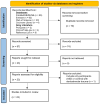Increased Risk of Dentoalveolar Trauma in Patients with Autism Spectrum Disorder: A Systematic Review with Meta-Analysis
- PMID: 39767406
- PMCID: PMC11675649
- DOI: 10.3390/ijerph21121563
Increased Risk of Dentoalveolar Trauma in Patients with Autism Spectrum Disorder: A Systematic Review with Meta-Analysis
Abstract
The prevalence of traumatic dental injuries (TDI) in patients with autism spectrum disorders (ASD) remains unclear. Given these discrepancies, an updated review of the evidence on the risk of TDI in patients with ASD is essential. This systematic review and meta-analysis aimed to evaluate the prevalence of TDI in patients with ASD and compare it to that in neurotypical patients. This study protocol was registered on PROSPERO (CRD42024580127) and followed the Cochrane Handbook for Systematic Reviews of Interventions and PRISMA guidelines. A comprehensive search of four databases-MEDLINE/PubMed, Web of Science, Scopus, and Embase-was conducted for articles published up to August 2024. Moreover, the gray literature (ProQuest) and reference lists were screened. The inclusion criteria required participants with ASD to assess TDI across deciduous, mixed, and permanent dentition regardless of age. No restrictions were applied on TDI type, language, or publication date. Additionally, case reports, reviews, letters, and studies addressing other oral disorders without specific TDI data were excluded. A single-arm meta-analysis evaluated the cumulative proportion and 95% confidence interval (CI) of TDI in patients with ASD. Moreover, a comparative meta-analysis was performed to assess the risk of TDI between ASD and neurotypical patients, calculating the odds ratio (OR) with a 95% CI, and a p < 0.05 was deemed significant, using the R program. Quality assessment was performed using the National Heart, Lung, and Blood Institute tool, and the certainty of evidence was evaluated using GRADE. A total of 22 studies were included to determine the overall prevalence of TDI, of which 16 studies directly compared patients with ASD to neurotypical individuals. In total, 3817 participants were evaluated, including 2162 individuals with ASD and 1655 neurotypical patients. A single-arm meta-analysis estimated a TDI prevalence of 22% (Confidence Interval [CI]: 17-27%) among patients with ASD. A significant difference in the risk was observed between ASD and neurotypical patients (p = 0.003; Odds Ratio [OR]: 1.67; CI: 1.19-2.26). However, substantial heterogeneity was observed in this analysis. Although the majority of studies were rated as high quality, the certainty of the evidence was considered very low. Despite the limitations of this study, the findings suggest that patients with ASD are at a higher risk of developing TDI than the risk observed in neurotypical patients. Therefore, preventive educational initiatives are recommended to reduce the risk of TDI in this population.
Keywords: autistic disorder; dental trauma; dentoalveolar trauma; special need.
Conflict of interest statement
The authors declare no conflicts of interest.
Figures




References
-
- Association A.P. Diagnostic and Statistical Manual of Mental Disorders—DSM-5-TR. 5th ed. Volume 5. American Psychiatric Association Publishing; Washington, DC, USA: 2022. p. 1377.
-
- Maenner M.J., Warren Z., Williams A.R., Amoakohene E., Bakian A.V., Bilder D.A., Durkin M.S., Fitzgerald R.T., Furnier S.M., Hughes M.M., et al. Prevalence and Characteristics of Autism Spectrum Disorder Among Children Aged 8 Years-Autism and Developmental Disabilities Monitoring Network, 11 Sites, United States, 2020. MMWR Surveill. Summ. 2023;72:1–14. doi: 10.15585/mmwr.ss7202a1. - DOI - PMC - PubMed
Publication types
MeSH terms
LinkOut - more resources
Full Text Sources
Medical

